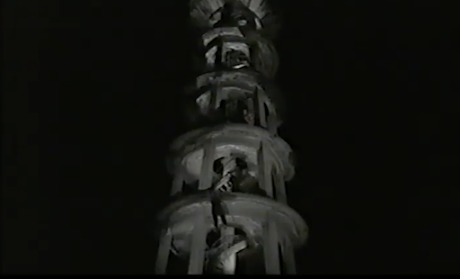"The longer the hair, the stupider you get."
A prominent London businessman is found in a hotel room with a knife through his heart and a mysterious glass eyeball nearby and, the next day, showgirl Laila (Heidrun Hankammer), who was with the victim at the time, is found dead backstage. Inspector Perkins (Horst Tappert) is on the case, with the help of the libidinous Sir Arthur (Hubert von Meyerinck) and squeaky-voiced Sergeant Pepper (Stefan Behrens). But the investigation soon uncovers a sinister plot involving organized crime, human trafficking and drug smuggling. Who is the mysterious masked vigilante killing off members of the cartel? What dark secrets is showgirl Yvonne hiding? And will Scotland Yard be able to stop the sinister plot in time?
The Man With the Glass Eye (not to be confused with The Man With Icy Eyes or Eyes of Crystal or Blue Eyes of the Broken Doll) is the 14th and final adaptation in Rialto Films' Edgar Wallace series and viewers will recognize familiar tropes from the other films: organized crime, hidden rooms, backstage theater drama, and devious upper-class criminals. This one is really more krimi than giallo, but the presence of a masked killer blurs the genre lines a bit. It's a fast-paced crime caper with a complex plot, some good action scenes, a bit of humor and a satisfying ending.
• I've checked "Inept Police" above, despite the fact that the police solve the crime and save the day. This is in regards to Sir Arthur, who recommends the wrong course of action at every turn. The case is solved by going against his instincts.
• Out of everyone in the cast, viewers outside of Germany might recognize Fitz Wepper (Yvonne's boyfriend Bruce) as Fritz Wendel in the 1972 film adaptation of Cabaret.
• There are actually lots of glass eyes in this movie. There's the crime boss, who has a literal glass eye who hides out in a billiard hall called "The Glass Eye." The killer, is also shown with one white eye and the pass key to get into the smugglers lair is a glass marble, painted to look like an eyeball, which lots of people (including one child) have in their possession. The title might also refer to the cameras that the mobsters have hidden around the billiard hall.
What the Hell am I Watching?
Along with the Las Vegas Girls and Rubiro the knife thrower, one of the acts in the nightclub show is a nosy ventriloquist with a truly disturbing dummy.
Late in the movie, the killer wears the dummy head as a mask while taking out a victim.
Fashion Moment
The Las Vegas Girls official color seems to be teal. we see them wearing it on and off stage.
Here we see Laila wearing the poisoned mask.
And, finally a look at the killer's outfit - a classic giallo look except for the white mask, which seems to be a staple of this Rialto Films series.



















































